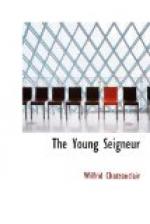“I do not think so,” interrupted Chrysler laughing, “I might put you fifty years behind the age, but no further.”
“Yes, but you, sir, have seen us. Why do not more of you come and see?”
“For some of the same reasons perhaps why you do not know us.”
Some distance past the Church northward, the village, obscured by the great, irregularly-occurring pines, takes a turn and a sudden dip. The dip and the pines, which are thick at that end, obscure a section of the village known locally as La Reveilliere.
As they came to the high ground where the dip occurs, the vista appeared below of a spacious avenue, down whose centre ran a straight and smooth road-bed, and on either side twice its breadth of lawn, rolled and cut, forming a sort of common, ornamented by a sparing group or two of the ubiquitous pines of the neighbourhood. Along the edges of this avenue or common, lay what could only be called a sort of transfigured French-Canadian village, looking, in the quiet light of evening, as if pictured by some artist out of studies of the places in the country about. The dwellings were larger, better drawn, their windows, attics and wings more varied in design, but amid their picturesque variety could be discerned in several, a suggestion of the chimney of a certain wild little cot in a dell near the Manoir; in others, of the solid stone home of Jean Benoit; in many the chalet-eaved pattern of the ordinary cottage. Perhaps the latter were made prettiest of all—they were at least the airiest looking. It was in the colors and stainings applied to the gables and other parts that the greatest care had been taken. These were selected out of the ordinary red, yellow, white, and sage-green washes in common use, with such taste as to effect a deeply harmonious and ideal issue. Again, the plan of the village was peculiar. It was simply an improvement on that of the local villages in general, the dwellings being upon the border of the street and not far apart, with their little, foot-wide flower-gardens close against the front. The circular fan of a patent windmill lifted itself lightly, the most prominent object in the settlement, and a charming Gothic schoolhouse crouched farther down on the opposite side. Behind the houses, growths of trees formed an enclosing background, according to the tastes of the owners, but guided by some harmonizing supervision like the colors. And at a short distance the avenue was crossed by a white poplar grove, which brought the scene to a limit, and separated this dream of a rural statesman from the common world.
“V’la, monsieur,” said Zotique, who had joined them, stretching his hand, “Behold the cherished work of our young seigneur.”
Upon the galleries, the verandahs, the green lawn, the picture moved with life. A half-haze, precursive of the twilight, lent scenic softness to the forms of old men puffing their pipes before the doors, a maiden listlessly strolling on the sward, a swarm of children playing near the road, a distant toiler making his way home, bearing his scythe. The visitors went down into the place and Chrysler saw that the artistic shapes and ideal colors were worn with daily use, the men and women, serene-looking, were still the every day mortals of the region.




